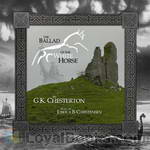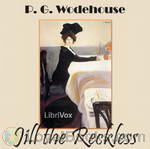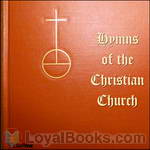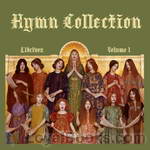|
Books Should Be Free Loyal Books Free Public Domain Audiobooks & eBook Downloads |
|
|
Books Should Be Free Loyal Books Free Public Domain Audiobooks & eBook Downloads |
|
Music Books |
|---|
|
Book type:
Sort by:
View by:
|
By: Thomas Hardy (1840-1928) | |
|---|---|
 Under the Greenwood Tree
Under the Greenwood Tree
This novel is subtitled The Mellstock Quire, A Rural Painting of the Dutch School. The Quire is the group of musicians who accompany the hymns at the local church and we follow the fortunes of one member, Dick Dewy, who falls in love with the new school mistress, Fancy Day. Another element of the book is the battle between the traditional musicians of the Quire and the local vicar, Parson Maybold, who installs a church organ. This battle illustrates the developing technology being introduced in the Victorian era and its threat to traditional country ways... | |
By: G. K. Chesterton (1874-1936) | |
|---|---|
 The Ballad of the White Horse
The Ballad of the White Horse
An English epic poem that follows the exploits of Alfred the Great in his defense of Christian civilization in England from the heathen nihilism of the North. Following a string of defeats at the hands of the invading Danes, a vision from heaven in the river island of Athelney fills Alfred with joy and hope. Though it gives no promise of victory in the coming struggle, it inspires him to rally his chieftains for a last stand against the invading hordes. His adventures lead throughout the country... | |
By: Joseph Conrad (1857-1924) | |
|---|---|
 Victory: An Island Tale
Victory: An Island Tale
Recollections of the life of Axel Heyst, one-time manager of the liquidated Tropical Belt Coal Company in a fictitious island in the Pacific. After retreating from society in response to his professional failures, the misanthrope is drawn back by a romantic affair. (Introduction by S. Kovalchik) | |
By: Joel Chandler Harris (1848-1908) | |
|---|---|
 Uncle Remus
Uncle Remus
Bearing a striking resemblance to Aesop of Aesop's Fables fame, American author Joel Chandler Harris' Uncle Remus is also a former slave who loves to tell simple and pithy stories. Uncle Remus or to give it its original title, Uncle Remus: His Songs and His Sayings was published in late 1880 and received instant acclaim. The book was reviewed in hundreds of journals and newspapers across the country, leading to its immense success, both critical and financial. “Remus” was originally a fictional character in a newspaper column... | |
By: P. G. Wodehouse (1881-1975) | |
|---|---|
 Jill the Reckless
Jill the Reckless
Jill had money, Jill was engaged to be married to Sir Derek Underhill. Suddenly Jill becomes penniless, and she is no longer engaged. With a smile, in which there is just a tinge of recklessness, she refuses to be beaten and turns to face the world. Instead she goes to New York and becomes a member of the chorus of "The Rose of America," and Mr. Wodehouse is enabled to lift the curtain of the musical comedy world. There is laughter and drama in _Jill the Reckless_, and the action never flags from the moment that Freddie Rooke confesses that he has had a hectic night, down to the point where Wally says briefly "Let 'em," which is page 313... | |
By: Rabindranath Tagore (1861-1941) | |
|---|---|
 First Jasmines
First Jasmines
Rabindranath Tagore, was a Bengali polymath who reshaped Bengali literature and music, as well as Indian art with Contextual Modernism in the late 19th and early 20th centuries. Author of Gitanjali and its "profoundly sensitive, fresh and beautiful verse", he became the first non-European to win the Nobel Prize in Literature in 1913. In translation his poetry was viewed as spiritual and mercurial; however, his "elegant prose and magical poetry" remain largely unknown outside Bengal. Tagore introduced new prose and verse forms and the use of colloquial language into Bengali literature, thereby freeing it from traditional models based on classical Sanskrit... | |
By: W. S. Gilbert (1836-1911) | |
|---|---|
 The Bab Ballads
The Bab Ballads
The Bab Ballads are a collection of light verse by W. S. Gilbert, illustrated with his own comic drawings. Gilbert wrote the Ballads before he became famous for his comic opera librettos with Arthur Sullivan. In writing the Bab Ballads, Gilbert developed his unique “topsy-turvy” style, where the humour was derived by setting up a ridiculous premise and working out its logical consequences, however absurd. The Ballads also reveal Gilbert’s cynical and satirical approach to humour. They became famous on their own, as well as being a source for plot elements, characters and songs that Gilbert would recycle in the Gilbert and Sullivan operas... | |
By: Ludwig van Beethoven (1770-1827) | |
|---|---|
 Selected Letters of Beethoven
Selected Letters of Beethoven
A selection of Beethoven’s letters from the compilation by Dr. Ludwig Nohl and translated by Lady Grace Wallace. | |
By: Friedrich Nietzsche (1844-1900) | |
|---|---|
 Case of Wagner / Nietzsche Contra Wagner / Selected Aphorisms
Case of Wagner / Nietzsche Contra Wagner / Selected Aphorisms
A collection of three of Nietzsche's writings concerning the music of Wagner. In particular, he relates Wagner's music as degenerate, unrefined and unintelligent and relates it to a gradually degenerating German culture and society. The translator provides a detailed introduction. | |
By: John Meade Falkner (1858-1932) | |
|---|---|
 The Lost Stradivarius
The Lost Stradivarius
The Lost Stradivarius (1895), by J. Meade Falkner, is a short novel of ghosts and the evil that can be invested in an object, in this case an extremely fine Stradivarius violin. After finding the violin of the title in a hidden compartment in his college rooms, the protagonist, a wealthy young heir, becomes increasingly secretive as well as obsessed by a particular piece of music, which seems to have the power to call up the ghost of its previous owner. Roaming from England to Italy, the story involves family love, lordly depravity, and the tragedy of obsession | |
By: George Bernard Shaw (1856-1950) | |
|---|---|
 The Perfect Wagnerite
The Perfect Wagnerite
The Perfect Wagnerite: A Commentary on the Niblung's Ring (originally published London, 1898) is a philosophical commentary on Richard Wagner's Der Ring des Nibelungen, by the Irish writer George Bernard Shaw. Shaw offered it to those enthusiastic admirers of Wagner who "were unable to follow his ideas, and do not in the least understand the dilemma of Wotan." He interprets the Ring in Marxian terms as an allegory of the collapse of capitalism from its internal contradictions. Musicologically, his... | |
By: Friedrich Kerst | |
|---|---|
 Mozart, The Man and the Artist as Revealed in His Own Words
Mozart, The Man and the Artist as Revealed in His Own Words
Wolfgang Amadeus Mozart. His name is one of the most recognizable names in history and one of the most enduring of composers. At age 5, this “wunderkinder” took to the stage and began his life as a prolific and celebrated creator-genius of such luminous works the world has not known since. This collection of morsels taken from his personal letters is engaging and gives a look into the mind of the boy wonder. Was he mad? Was he miraculous? | |
By: Lilli Lehmann (1848-1929) | |
|---|---|
 How to Sing (Meine Gesangskunst)
How to Sing (Meine Gesangskunst)
Lilli Lehmann, born Elisabeth Maria Lehmann, was a German operatic soprano of phenomenal versatility. She was also a voice teacher.She wrote: "Every serious artist has a sincere desire to help others reach the goal—the goal toward which all singers are striving: to sing well and beautifully." This is the 1915 second (expanded) edition of her book and includes many illustrations and diagrams, both physiological and musical, which the listener will find useful.Much of Lilli Lehmann's advice is complex and demanding - the standards which she set for herself were beyond the highest aspirations of most professional singers... | |
By: Horatio Alger, Jr. (1832-1899) | |
|---|---|
 Grand'ther Baldwin's Thanksgiving, with Other Ballads and Poems
Grand'ther Baldwin's Thanksgiving, with Other Ballads and Poems
Horatio Alger, better known for his juvenile fiction, also penned some great poetry. His Ballads, including the 8 war poems and his odes, are collected in this volume. | |
By: Karl Wilson Gehrkens (1882-1975) | |
|---|---|
 Music Notation and Terminology
Music Notation and Terminology
Until relatively recently, music students at all levels of study—from the conservatories to public schools—had few resources available for the formal study of musical notation and terminology in the classroom. In fact, it was not until 1914, when Professor Karl Gehrkens at the Oberlin School of Music published this compilation of class notes and sources he collected over the years, that a uniform text became available for schools and universities everywhere. Since the publication of this monumental work, similar textbooks have emerged, but Dr... | |
By: Gustav Kobbé (1857-1918) | |
|---|---|
 How to Appreciate Music
How to Appreciate Music
Originally published in 1906, this book is essentially a how to guide on music appreciation. Includes sections on the pianoforte, orchestral, and vocal music. Good for anyone who wishes for a greater appreciation of the wonders of music. | |
By: Franz Liszt (1811-1886) | |
|---|---|
 Life of Chopin
Life of Chopin
Chopin was a romantic era Polish composer. This work is a memoir by Liszt who knew Chopin both as man and artist. This memoir gives a unique understanding to the psychological character of the compositions of Chopin. It also offers Liszt's insight into some of Chopin's polonaises, especially the grand polonaise in F sharp minor. Liszt explains the strange emotion "ZAL" which is inclosed in his compositions. Then, presents a brief sketch on the lives of other great people in Chopin's circle. After that, Liszt discusses Chopin's fame and early life. Finally, Liszt gives a detailed account on Chopin's sufferings due to ill health and the unfortunate departure of the great composer. | |
By: Henry Edward Krehbiel (1854-1923) | |
|---|---|
 How to Listen to Music
How to Listen to Music
This book is "not written for professional musicians, but for untaught lovers of the art". It gives broad instruction on composers, styles, instruments, venues - and when to believe the critics. | |
By: Friedrich Wieck (1785-1873) | |
|---|---|
 Piano and Song
Piano and Song
This book talks about teaching, learning and performing on the piano in a delightful style, alternating between conversation and instruction. As he was the father of Clara Schumann and Robert Schumann's teacher, need I say more? | |
By: William S. Gilbert (1836-1911) | |
|---|---|
 The Pirates of Penzance
The Pirates of Penzance
The Pirates of Penzance; or, The Slave of Duty is a comic opera in two acts, with music by Arthur Sullivan and libretto by W. S. Gilbert. The story concerns Frederic, who, having completed his 21st year, is released from his apprenticeship to a band of tender-hearted pirates. He meets Mabel, the daughter of Major-General Stanley, and the two young people fall instantly in love. Frederic finds out, however, that he was born on 29 February, and so, technically, he only has a birthday each leap year... | |
By: Arnold Kennedy (1853-1938) | |
|---|---|
 Merry Clappum Junction
Merry Clappum Junction
This is a jolly little book about a little boy, a dog, a train and a house. But not an ordinary train, oh no, and not an ordinary house either! And there are songs, too. The Preface is short, dull and only for the grown-ups. | |
By: W. S. B. Mathews (1837-1912) | |
|---|---|
 Popular History of the Art of Music
Popular History of the Art of Music
Preface by W.S.B. Mathews: I have here endeavored to provide a readable account of the entire history of the art of music, within the compass of a single small volume, and to treat the luxuriant and many-sided later development with the particularity proportionate to its importance, and the greater interest appertaining to it from its proximity to the times of the reader.The range of the work can be most easily estimated from the Table of Contents (pages 5-10). It will be seen that I have attempted to cover the same extent of history, in treating of which the standard musical histories of Naumann, Ambros, Fétis and others have employed from three times to ten times as much space... | |
By: James Huneker (1860-1921) | |
|---|---|
 Chopin: The Man and His Music
Chopin: The Man and His Music
A biography of the Polish composer and virtuoso pianist Frédéric Chopin and a critical analysis of his work by American music writer and critic James Huneker. | |
By: Charles Rogers (1825-1890) | |
|---|---|
 Modern Scottish Minstrel
Modern Scottish Minstrel
Subtitled "Songs of Scotland of the Past Half-Century, with Memoirs of the Poets, and Sketches and Specimens in English Verse of the Most Celebrated Modern Gaelic Bards." | |
By: Josephine Preston Peabody (1874-1922) | |
|---|---|
 After Music
After Music
Josephine Preston Peabody was an American poet and dramatist. She was born in New York and educated at the Girls’ Latin School, Boston, and at Radcliffe College. | |
By: Aubertine Woodward Moore (1841-1929) | |
|---|---|
 For Every Music Lover
For Every Music Lover
A series of essays for music lovers, covering many topics. From music appreciation, to violin and symphony, music education, to piano and, in fact, the very origins of music, there is sure to be something for everyone. | |
By: W. S. Gilbert (d 1911) | |
|---|---|
 More Bab Ballads
More Bab Ballads
This is a subset of the first twelve poems from the second collection of Gilbert’s “Bab Ballads” – light verses poking fun at the life and people of his time in Gilbert’s unique “topsy-turvey” style. The epitaph on his memorial on the Victoria Embankment in London is “HIS FOE WAS FOLLY AND HIS WEAPON WIT”, an epitaph amply exemplified in these verses. | |
By: Ralph Chaplin (1887-1961) | |
|---|---|
 Bars and Shadows: The Prison Poems of Ralph Chaplin
Bars and Shadows: The Prison Poems of Ralph Chaplin
Ralph Chaplin and many other prominent members of the Industrial Workers of the World were imprisoned under the Espionage Act of 1917 as the United States entered World War I. As with Socialist presidential candidate Eugene V. Debs, these activists were accused of undermining recruiting efforts and the draft - even of encouraging soldiers to desert. Though they never gained the universal popularity of his anthem "Solidarity Forever," the poems and songs in this volume - composed during his four years in prison - represent the defiant attitude of a true rebel in the face of persecution. | |
By: Jessie Fothergill (1851-1891) | |
|---|---|
 The First Violin
The First Violin
May Wedderburn is a quiet provincial girl, living in small and seemingly boring Skernford. Underneath the dull exterior, there is mystery, suspicion and fear in this little town, surrounding the austere local wealthy landowner who is very interested in marrying poor May. It looks as though she will have to marry him whether she likes it or not until an unsuspected alliance is formed between her and a respected old lady. They both escape to Germany where music and excitement await them. | |
By: Christopher Wilson (1874-1919) | |
|---|---|
 Shakespeare and Music
Shakespeare and Music
Shakespeare's plays are full of music: love songs, comic ditties, serious ballads, and songs for witches and spirits. Over the centuries musicians and composers have also created musical adaptations based on Shakespeare's plays. Composer Christopher Wilson's Shakespeare and Music (1922) documents the musical history of each play across various genres, including opera and incidental music. | |
By: John H. Swaby (?-1891) | |
|---|---|
 Physiology of the Opera
Physiology of the Opera
Trust Scrici for a tell all, no holds barred exposé of the modern opera . . . well, modern as of . . . er . . . say, 1852. | |
By: Various | |
|---|---|
 Christmas Carol Collection
Christmas Carol Collection
Though carols are traditionally associated with Christmas, this was not always the case. “Carol” comes from the French word 'carole' which means circle dance accompanied by singing. It was part of any festivity and gradually came to be associated with holidays like Christmas. In England, festivities were banned following the Civil War and Protestantism, but many song writers and Protestants wrote musical works to be sung at Christmas and these were referred to as “carols.” Today, Christmas anywhere in the world is incomplete without carol singers and songs... | |
 Hymns of the Christian Church
Hymns of the Christian Church
A collection of classic Christian hymns spanning the centuries. Some of the hymns are read; others are sung. | |
By: Unknown | |
|---|---|
 Folk Ballad Collection
Folk Ballad Collection
First collection of sung and spoken folk ballads (13 in collection). | |
By: Various | |
|---|---|
 Hymn Collection
Hymn Collection
A selection of twenty hymns sung in this recording. | |
By: May Gillington Byron (-1936) | |
|---|---|
 Days with the Great Composers
Days with the Great Composers
These light entertainments, originally published anonymously, are an imagined day in the life of each composer (Beethoven, Mendelssohn, Schubert, Chopin, Wagner, Gounod, Mozart, Schumann, Tschaikovsky). This gives the author scope to describe each one's work and life, sketchily, of course, but interestingly. | |
By: Various | |
|---|---|
 Public Domain Hymns - 01
Public Domain Hymns - 01
"Originally modeled on the Psalms and other poetic passages (commonly referred to as "canticles") in the Scriptures, Christian hymns are generally directed as praise and worship to the monotheistic God. Many refer to Jesus Christ either directly or indirectly. Since the earliest times, Christians have sung "psalms and hymns and spiritual songs", both in private devotions and in corporate worship (Matthew 26:30; 1 Cor 14:26; Ephesians 5:19; Colossians 3:16; James 5:13; cf. Revelation 5:8-10; Revelation 14:1-5)... | |
By: Owen Wister (1860-1938) | |
|---|---|
 Padre Ignacio, Or The Song Of Temptation
Padre Ignacio, Or The Song Of Temptation
Padre Ignacio has been the pastor of California mission Santa Ysabel del Mar for twenty years. In 1855 a stranger rides into the mission bringing news and a spiritual crisis. It's really more of a novella than a novel. | |
By: Elsa Gidlow (1898-1986) | |
|---|---|
 On a Grey Thread
On a Grey Thread
On a Grey Thread was first published in 1923, one of the first books of openly lesbian love poetry to be published in the United States. Her early verse is concise and highly original. | |
By: William Butler Yeats (1865-1939) | |
|---|---|
 Wind Among the Reeds (Version 2)
Wind Among the Reeds (Version 2)
The Wind Among the Reeds was first published in 1899 and features short, personal lyrics on subjects such as Irish legends and personal relationships. - Summary by Newgatenovelist | |
By: Laurence Hope (1865-1904) | |
|---|---|
 Garden of Kama
Garden of Kama
Laurence Hope was the nom de plume of Adela Florence Nicolson, a British poet who wrote verses inspired by India, where she lived. This collection, her first, was originally published in 1901. | |
By: Maria Letitia Stockett (1884-1949) | |
|---|---|
 Hoofs of Pegasus
Hoofs of Pegasus
Maria Letitia Stockett was a highly respected English teacher in Baltimore, Maryland, but also well-known as an author. In addition to her poetry she wrote Baltimore: A Not Too Serious History in 1928, and America, First, Fast & Furious . This is a collection of her short lyrical poems of nature, sentient and spirit. - Summary by Larry Wilson | |
By: John Hall Wheelock (1886-1978) | |
|---|---|
 Black Panther
Black Panther
John Hall Wheelock is an American poet who during his student years at Harvard University was editor-in-chief of The Harvard Monthly, and began to publish his first poems. He later worked for publisher Charles Sribner and Sons finally becoming senior editor. He received many awards for his poetry including the Golden Rose in 1936 for the most distinguished contribution to American poetry of that year. The poems in The Black Panther reveal a deep spirituality but also a strong humanistic reach, sometimes dark and sometimes celebratory and full of joy... | |
By: John Mason Neale (1818-1866) | |
|---|---|
 Mediaeval Hymns and Sequences
Mediaeval Hymns and Sequences
This book is a collection of English translations of medieval Latin hymns. It contains interesting historical and/or liguistic facts about each hymn, some of which are still used in one form or other in the modern Christian church.Note: An asterisk implies a belief that the piece so marked has not previously appeared in an English translation. - Summary by Devorah Allen | |
By: Katherine Hale (1874-1956) | |
|---|---|
 New Joan and Other Poems
New Joan and Other Poems
Katherine Hale is the pen name of Amelia Beers Warnock Garvin, a Canadian poet and literary critic. This volume is one of her collections with the background of World War I as a theme, but full of faith and hope. - Summary by Larry Wilson | |
By: Stella Benson (1892-1933) | |
|---|---|
 Twenty
Twenty
Twenty, Stella Benson’s first poetry collection, was first published in 1918. It deals with topics such as personal independence, the First World War and London’s landscape. | |
By: Zora Cross (1890-1964) | |
|---|---|
 Lilt of Life
Lilt of Life
Published in 1918, Zora Cross’s book of poems, The Lilt of Life, was her third book of verse, and, like her earlier works, largely focused on her experiences of love, erotic entanglements , and motherhood. Many of the poems are written as an homage to her then-husband, David McKee Wright, whom she met while writing for The Bulletin, where Wright was her editor, causing a significant scandal in Sydney literary circles. - Summary by Elise Dee | |
By: Felix Weingartner (1863-1942) | |
|---|---|
 Symphony Since Beethoven
Symphony Since Beethoven
This 1904 book by composer, conductor and pianist Felix Weingartner examines the development of the symphony as a musical form since one of its greatest practitioners, Ludwig van Beethoven. Beethoven's symphonic works gave the symphony an unprecedented importance as an art form and inspired his contemporaries and later composers to take it more seriously. Weingartner helped create a widespread appreciation for Beethoven's symphonies through his writings on, and performances of, these works. He conducted all of Beethoven's symphonies, and was the first conductor to make commercial recordings of all nine of them. | |
By: Elinor Jenkins (1893-1920) | |
|---|---|
 Poems
Poems
Elinor Jenkins was a British poet whose published work focuses largely on the First World War. This volume, based on her collection published in 1915, incorporates 16 later poems and was published posthumously in 1921. | |
By: Franz Hoffmann (1814-1882) | |
|---|---|
 Mozart's Youth
Mozart's Youth
This short account of the young Wolfgang Amadeus Mozart is part of the “Life Stories for Young People” series. It is written in an engaging dialogue format beginning with the young Mozart’s first notes on the piano keyboard at age three to his admission to membership in the Accademia Filarmonica at Bologna, Italy, ten years later. This child prodigy astounded the musical world of Europe to become one of the most cherished of all classical composers. | |
By: Tom Maguire (1865-1895) | |
|---|---|
 Machine-Room Chants
Machine-Room Chants
Tom Maguire was a trade union organiser from Yorkshire of Irish descent whose poetry reflects his socialist beliefs. This volume was published posthumously in 1895 and includes prefatory commemorative remarks by Keir Hardie and John Bruce Glasier. NB Listeners may find some of the references to sexual assault and suicide distressing. | |
By: Carl Sandburg (1878-1967) | |
|---|---|
 Love & Its Historical Shades: Poetic Expressions of Love Based on Varying Time Periods
Love & Its Historical Shades: Poetic Expressions of Love Based on Varying Time Periods
The theme around these poems is how poets expressed their ideas of love as well as the type of language used to convey said love through poetry; it also indirectly highlights how society may perceive love based on how those poets' values may have aligned with/against society during their era. All the poems revolve around a discussion of love through the language they used to describe their feelings of love as well as the images they paint through said language . | |
By: The National Society of Music | |
|---|---|
 Art of Music - Volume 01: The Pre-Classic Periods
Art of Music - Volume 01: The Pre-Classic Periods
Volume 1 in the "The Art of Music" series, published by the National Society of Music. This first volume covers the "Pre-Classic periods", from early human primitive music, through to the music of the Ancient Greeks and other ancient cultures, plainsong, Middle Ages, Renaissance, and up until the music of J.S. Bach. Included are musical examples, which are performed in the audio as they appear in the text. - Summary by Jake Malizia | |
By: John Stagg (1770-1823) | |
|---|---|
 Two Cumberland Ballads
Two Cumberland Ballads
Two narrative ballads, based on local lore, by the Cumberland poet John Stagg. In 'The Hermit of Rockcliffe', a young fugitive takes refuge with a hermit, hears a bizarre and cautionary tale of what might befall a lusty young man at a masked ball, and learns surprising news about himself. In 'The Rose of Corby' a young maid's elopement with her lover, on the day of her betrothal to a local lord, has an unexpected outcome. | |
By: Florence Henniker (1855-1923) | |
|---|---|
 Poesies from Abroad
Poesies from Abroad
Florence Henniker was a British poet and novelist whose ‘Poesies from Abroad’ was first published in Blackwood’s Edinburgh Magazine in September 1889. This collection also includes ‘An Autumn Lyric’, which was first published in May 1889 in the same journal. - Summary by Newgatenovelist | |
By: Gilbert Seldes (1893-1970) | |
|---|---|
 Seven Lively Arts
Seven Lively Arts
“... But, beside those great men, there is a certain number of artists who have a distinct faculty of their own by which they convey to us a peculiar quality of pleasure which we cannot get elsewhere; and these, too, have their place in general culture, and must be interpreted to it by those who have felt their charm strongly, and are often the objects of a special diligence and a consideration wholly affectionate, just because there is not about them the stress of a great name and authority.” - Summary by Walter Pater | |
By: The National Society of Music | |
|---|---|
 Art of Music - Volume 02: Classicism and Romanticism
Art of Music - Volume 02: Classicism and Romanticism
Volume 2 in the "The Art of Music" series, published by the National Society of Music. This first volume covers the Classical and Romantic periods, encompassing: Haydn, Mozart, Beethoven, opera in Italy and France, Romanticism, song literature, pianoforte and chamber music, orchestral literature, romantic opera, choral song, Wagner and Wagnerism, Brahms, Franck, Verdi and other contemporaries. - Summary by Jake Malizia | |
By: Charles Edward de la Poer Beresford (1850-1921) | |
|---|---|
 Happy New Year and Other Verses
Happy New Year and Other Verses
This is a collection of 27 poems, some seasonal to New Years and Christmas, but others on themes of religion, nature and home. | |
By: Walter Seymour Percy (1867-1935) | |
|---|---|
 Muse and Mint
Muse and Mint
Born in Ontario, Canada, Walter Percy entered the ministry and pastored churches in New England and Pennsylvania, often speaking on behalf of the temperance movement. Many of his poems were written for his children and are here collected under the topics: nature, fireside, sentiment, memories, philosophy, homilies, country, humor. sacred, song poems, and miscellaneous poems. - Summary by Larry Wilson | |
By: John Newton (1725-1807) | |
|---|---|
 Messiah: Fifty Expository Discourses on the Oratorio of Handel
Messiah: Fifty Expository Discourses on the Oratorio of Handel
The celebrated German-British composer G.F. Handel premiered his now famous oratorio "Messiah" in 1742. In 1785 there was a celebration at Westminster Abbey of Handel's birth 100 years before. It was on this occasion that John Newton decided to preach 50 sermons from the Bible passages that form the libretto of Messiah. The sermons were preached over two years in the Parish Church of St. Mary Woolnoth, Lombard-Street - 3 miles from Westminster Abbey. - Summary by InTheDesert | |
By: Eleanor Mary Smith-Dampier | |
|---|---|
 Norse King's Bridal
Norse King's Bridal
In these translations from the Danish the author attempted to adhere strictly to the metres of the original, however in some, where this was not possible, she developed her own interpretations. | |
By: Alice Meynell (1847-1922) | |
|---|---|
 Later Poems
Later Poems
Alice Meynell was a British poet and suffragist. This collection was published in 1902 and explores the author’s Catholic faith as well as the natural world. - Summary by Newgatenovelist | |
By: William Wilfred Campbell (1860-1918) | |
|---|---|
 Sagas of Vaster Britain
Sagas of Vaster Britain
A collection of poems by the Canadian poet William Wilfred Campbell addressing themes of National Identity, Imperialism and the Divinity of Man. - Summary by Alan Mapstone | |
By: Vernon Blackburn (1866-1907) | |
|---|---|
 Fringe of an Art: Appreciations in Music
Fringe of an Art: Appreciations in Music
A collection of essays on things musical by Vernon Blackburn, including composers, music in different time periods, and modern music. | |
By: Mikhail Yurevich Lermontov (1814-1841) | |
|---|---|
 Six lyrics from the Ruthenian of Taras Shevchenko, also The Song of the Merchant Kalashnikov from the Russian of Mikhaíl Lermontov
Six lyrics from the Ruthenian of Taras Shevchenko, also The Song of the Merchant Kalashnikov from the Russian of Mikhaíl Lermontov
Poetry by two radical poets, born in the same year, who suffered exile and punishment under the Tsarist Russian empire. Taras Shevchenko is celebrated as the founder of Ukrainian literature , while Lermontov wrote in Russian. Both died young, Lermontov in a duel and Shevchenko as a result of his sufferings in exile. This collection includes Ethel Voynich's moving biography of Taras Shevchenko and translations of six short lyrics written over the course of his life, as well as her translation of Lermontov's narrative poem, The Song of the Merchant Kalashnikov. - Summary by Phil Benson | |
By: F. W. Harvey (1888-1957) | |
|---|---|
 Love Poems
Love Poems
F. W. Harvey was an English poet, broadcaster and solicitor. These poems, taken from his 1921 collection Farewell, embody his love of nature, his native Gloucestershire and his beloved. - Summary by Newgatenovelist | |
By: Romain Rolland (1866-1944) | |
|---|---|
 Handel
Handel
As Romain Rolland indicates in the preface, this book is a brief sketch of the life and technique of Handel. He provides biographical background and addresses the operas, oratorios, clavier compositions, chamber music, and orchestral compositions. Images of musical examples mentioned by Rolland can be found in the printed text. The text also includes a list of Handel's works organized by category and chronology. | |
By: Herbert Francis Peyser (1886-1953) | |
|---|---|
 Mendelssohn And Certain Masterworks
Mendelssohn And Certain Masterworks
In the compass of the present pamphlet it is impossible to give more than a cursory survey of Mendelssohn’s happy but extraordinarily crowded life. He was only slightly less prolific a composer than such masters as Bach, Mozart or Schubert, even if he did not reach the altitude of their supreme heights. But irrespective of the quality of much of his output, the sheer mass of it is astounding, the more so when we consider the extent of his travels and the unceasing continuity of his professional and social activities, which immensely exceeded anything of the kind in the career of Schubert or Bach. - Summary by Author's Foreword | |
By: Various | |
|---|---|
 Selections from The Army and Navy Hymnal, Volume 1
Selections from The Army and Navy Hymnal, Volume 1
This collection was a joint effort by the chaplains of the US Army and the Navy to meet the needs of divine services conducted in the Army and Navy, and for, in the compilers' words, "the upbuilding up patriotic citizenship." These 20 hymns from the book were selected by the singers. "Fairest Lord Jesus" sung by Kimberly Krause and TriciaG "Safe in the Arms of Jesus" sung by by Dulcimergirl and Kimberly Krause | |
By: Edward Baxter Perry (1855-1924) | |
|---|---|
 Descriptive Analyses of Piano Works
Descriptive Analyses of Piano Works
A look at the poetic motivations behind certain piano works. An understanding of these pieces on purely poetic grounds, with little insight into the technical or objective side of the music. How to understand the pieces in terms of an assumed poetical meaning for performer and listener. | |
By: Anonymous | |
|---|---|
 Lily Of The West
Lily Of The West
"Lily of the West is an Irish folk poem. Some say it is a metaphor for the Irish life after emigrating to America." . | |
By: Herbert Francis Peyser (1886-1953) | |
|---|---|
 Wolfgang Amadeus Mozart
Wolfgang Amadeus Mozart
Mozart’s earthly career was so poignantly short yet so filled with incalculable achievement that the author of this booklet finds himself confronted with an impossible task. He has, consequently, preferred to outline as best he could in the space at his disposal a few successive details of a life that was amazingly crowded with incident, early triumphs, and subsequent crushing tragedies, rather than to consider (let alone evaluate) the staggering creative abundances the master bequeathed mankind. | |
By: Albert Schweitzer (1875-1965) | |
|---|---|
 J.S. Bach, Volume 1
J.S. Bach, Volume 1
An analysis of Johann Sebastian Bach's life and musical compositions, and of the artistic, philosophical, and religious world in which he acted. (Introduction by Kathleen Norland) | |
By: Various | |
|---|---|
 Selections from The Army and Navy Hymnal, Volume 2
Selections from The Army and Navy Hymnal, Volume 2
This collection was a joint effort by the chaplains of the US Army and the Navy to meet the needs of divine services conducted in the Army and Navy, and for, in the compilers' words, "the upbuilding of patriotic citizenship." These 20 hymns from the book were selected by the singers. | |
By: Otto Jahn (1813-1869) | |
|---|---|
 Life of Mozart Volume 1
Life of Mozart Volume 1
An in depth look into the life of one of the greatest ever composers and musicians. Mozart was truly a gifted individual and this is an interesting look at both his family life and his musical career. | |
By: Robert Burns (1759-1796) | |
|---|---|
 Will ye go to the Indies, my Mary?
Will ye go to the Indies, my Mary?
A LibriVox' Weekly Poetry tribute to Robbie Burns on the upcoming Robbie Burns Day. (January 25) Robert Burns (also known as Robbie Burns, Rabbie Burns, Scotland's favourite son, the Ploughman Poet, Robden of Solway Firth, the Bard of Ayrshire and in Scotland as The Bard) was a Scottish poet and lyricist. He is widely regarded as the national poet of Scotland and is celebrated worldwide. He is the best known of the poets who have written in the Scots language, although much of his writing is also in English and a light Scots dialect, accessible to an audience beyond Scotland... | |
By: Herbert Francis Peyser (1886-1953) | |
|---|---|
 Schubert And His Works
Schubert And His Works
This is a short introduction to Franz Schubert’s life and works. “…to give the casual radio listener a slight idea of Schubert’s inundating fecundity and inspiration. Like Bach, like Haydn, like Mozart, Schubert’s capacity for creative labor staggers the imagination… Volumes would not exhaust the wonder of his myriad creations. If this tiny book serves to heighten even a little the reader’s interest in such songs, symphonies, piano or chamber works of Schubert as come to his attention over the air it will have achieved the most that can be asked of it.” This book was published by The Philharmonic Symphony Society of New York. | |
By: Various | |
|---|---|
 Favorite Hymns 01
Favorite Hymns 01
From the earliest period of history, God's people have found joy in expressing their praise to Him in song. This is a collection of 30 favorite public domain hymns of the Christian church. Summary by bookAngel7 | |
By: Pitts Sanborn (1879-1941) | |
|---|---|
 Ludwig Van Beethoven
Ludwig Van Beethoven
The late Pitts Sanborn wrote this booklet under the title Beethoven and his Nine Symphonies... I have left Mr. Sanborn’s pages on the symphonies virtually intact and have only expanded the work a little by incorporating here and there matter about other major works of Beethoven’s, especially some of the concertos, overtures, piano and vocal works, besides certain of the greater specimens of his chamber music.,,, I have followed it in order to supply a rather fuller picture of the composer’s creative achievements. - Summary by Editor's Note | |
By: Louis Biancolli (1907-1992) | |
|---|---|
 Tschaikovsky And His Orchestral Music
Tschaikovsky And His Orchestral Music
Included in this little book are analyses and backgrounds of most of Tschaikowsky’s standard concert music. A short sketch of Tschaikowsky’s life precedes the section devoted to the orchestral music. Yet, the personal outlook and moods of Russia’s great composer are so inextricably bound up with his music, that actually the whole booklet is an account of his strangely tormented life. In the story of Tschaikowsky, life and art weave into one closely knit fabric. It is hoped that this simple narrative will aid music lovers to glimpse the great pathos and struggle behind the music of this sad and lonely man. - Summary by Author's Foreword | |
By: Herbert Francis Peyser (1886-1953) | |
|---|---|
 Joseph Haydn; Servant And Master
Joseph Haydn; Servant And Master
Haydn, barring a few hardships in his youth, lived an extraordinarily fortunate life and had abundant reason for the optimism which marked every step of his progress.... Haydn was a master by the grace of Heaven and a servant only by the artificial conventions of a temporary social order... About the vast number of symphonies, the magnificent string quartets, the clavier works, the songs there can here be no question. - Summary by Author's Foreword | |
 George Frideric Handel
George Frideric Handel
Handel’s long career resembles a gigantic tapestry, so bewilderingly crowded with detail, so filled with turmoil and vicissitude, with vast achievements, extremes of good and ill fortune, and unending comings and goings that any attempt to force even a small part of it into the frame of a tiny, unpretentious booklet of the present sort is as hopeless as it is presumptuous.... Handel was time and again a composer of exquisitely delicate colorations, and sensuous style, not to say a largely unsuspected master of many subtle intricacies of rhythm... | |
By: Nina Ruth Davis Salaman (1877-1925) | |
|---|---|
 Voices of the Rivers
Voices of the Rivers
Nina Salaman was a noted scholar, translator and columnist. As well as translating medieval Hebrew poetry, she was a poet in her own right. This collection, first published in 1910, shows her remarkable grace. | |
By: Herbert Francis Peyser (1886-1953) | |
|---|---|
 Richard Strauss
Richard Strauss
There was not much truly spectacular about the course of [Strauss's] life, which was most happily free from the material troubles which bedeviled the existence of so many great masters... If “Salome” and “Elektra”, “Ein Heldenleben” and “Till Eulenspiegel” were in their day scandalously “sensational” did not the whirligig of time reveal them as incontestable products of genius, irrespective of inequalities and flaws? However Richard Strauss compares in the last analysis with this or that master he contributed to the language of music idioms, procedures and technical accomplishments typical of the confused years and conflicting ideals out of which they were born... | |
 Robert Schumann, Tone Poet Prophet And Critic
Robert Schumann, Tone Poet Prophet And Critic
[This is] the sketchiest outline of Robert Schumann’s short life but amazingly rich achievement. Together with Haydn and Schubert he was, perhaps, the most completely lovable of the great masters. It is hard, moreover, to think of a composer more strategically placed in his epoch or more perfectly timed in his coming. Tone poet, fantast, critic, visionary, prophet—he was all of these! And he passed through every phase, it seemed, of romantic experience. The great and even the semi-great of a fabulous period of music were his intimates—personages like Mendelssohn, Chopin, Liszt, Moscheles, Ferdinand David, Hiller, Joachim, Brahms... | |
By: Augusta Webster (1837-1894) | |
|---|---|
 English Stornelli
English Stornelli
In this sequence Augusta Webster experimented with eight-line verses grouped thematically by the seasons of the year. These poems also explore the cyclical stages of life from youth, courtship and parenthood through age and loss. Summary by Newgatenovelist. | |
By: Alexander Wheelock Thayer (1817-1897) | |
|---|---|
 Life of Ludwig Van Beethoven, Vol. 1
Life of Ludwig Van Beethoven, Vol. 1
The first of three volumes of the first scholarly biography of Ludwig van Beethoven. Covers the years 1770-1802. - Summary by Zain Solinski | |
By: Louis Fitzgerald Benson (1855-1930) | |
|---|---|
 Best Church Hymns
Best Church Hymns
This 1898 book is the result of a survey of 107 hymn-books. The thirty-two hymns are ranked in order of popularity. The texts in this recording are said only, not sung, along with a few explanatory notes for each hymn . The texts are preceded by two essays concerning hymns and their standards. Benson was an American Presbyterian minister who edited several hymnals. - Summary by David Wales | |
By: Gladys Davidson | |
|---|---|
 Stories From The Operas
Stories From The Operas
"Owing to the appreciation which has been accorded to my three series of "Stories from the Operas," it has been decided to re-issue the collection in one volume, and to include in this additional stories of new and popular operas recently produced in England.The plan of the work, as before, is to present all the incidents of each libretto in the clear, readable form of a short story; and it is hoped that the combined volume will continue to prove of interest, not only to opera-goers but to all lovers of dramatic tales. The three volumes have been entirely reset and re-collated in a manner which it is hoped will make them easier for reference." - Summary by Gladys Davidson | |
By: Theodore Wratislaw (1871-1933) | |
|---|---|
 Some Verses
Some Verses
Theodore Wratislaw was a fin de siècle poet and a less famous Decadent author than some of his contemporaries. This short collection of verse was first published in 1892. | |
 Orchids
Orchids
Theodore Wratislaw was a fin de siècle poet and a less famous Decadent author than some of his contemporaries. This short collection of verse was first published in 1896. | |
By: Lawrence Gilman (1878-1939) | |
|---|---|
 Stories of Symphonic Music
Stories of Symphonic Music
'A guide to the meaning of important symphonies, overtures and tone-poems from Beethoven to the present day'. Gilman became notorious for scathing reviews of compositions later to become classics. Here he analyzes the stories behind some famous and not so famous works. - Summary by Lynne Thompson | |
By: Mary Coleridge (1861-1907) | |
|---|---|
 Poems
Poems
Mary Coleridge was a novelist, essayist and biographer. She was also a talented poet, and her posthumously published verses are variously meditative, joyous, gothic, wistful and devotional. | |
By: Henry Lawson (1867-1922) | |
|---|---|
 Verses Popular And Humorous (Version 2)
Verses Popular And Humorous (Version 2)
Verses, Popular and Humorous was the second collection of poems by Australian poet Henry Lawson. It features some of the poet's earlier major works, including "The Lights of Cobb and Co", "Saint Peter" and "The Grog-An'-Grumble-Steeplechase". Most of the poems in the volume had been written after the publication of In the Days When the World was Wide and Other Verses in 1896. The original collection includes 66 poems by the author that are reprinted from various sources. Later publications split the collection into two separate volumes: Popular Verses and Humorous Verses, though the contents differed from the original list... | |
By: Elizabeth Siddal (1829-1862) | |
|---|---|
 Selected Poems
Selected Poems
Elizabeth Siddal was a British poet, artist and model. Her poems were not published in a single volume in her lifetime; this collection brings together fifteen of her verses on themes such as loss and relationships. Summary by Newgatenovelist | |
By: Sir Philip Sidney (1554-1586) | |
|---|---|
 Double Sestina - Ye Goatherd Gods
Double Sestina - Ye Goatherd Gods
volunteers bring you recordings of Double Sestina - Ye Goatherd Gods by Phillip Sidney. This was the Fortnightly Poetry project for May 5, 2019. ------ Poem is included in the book "Countesse of Pembroke's Arcadia" Ye Goatherd Gods" depicts the sorrows of two shepherds who love the same woman. She has left them both, however, and the two shepherds are dejected and heartbroken. They appeal to the gods, to nature, and to the heavens in their angst, and everything they see is altered because of their sorrows... | |